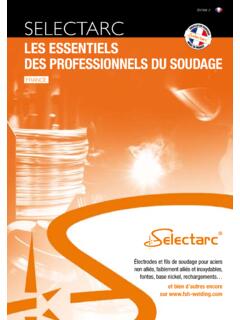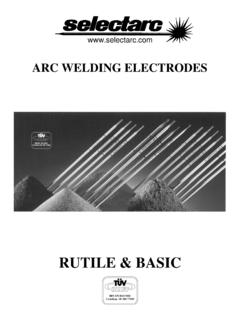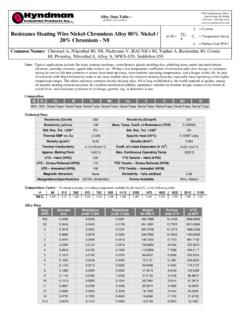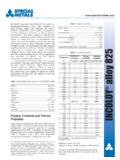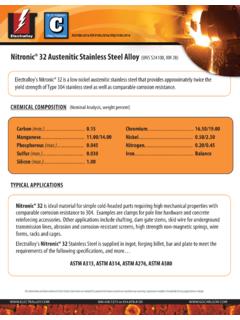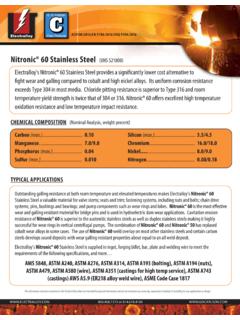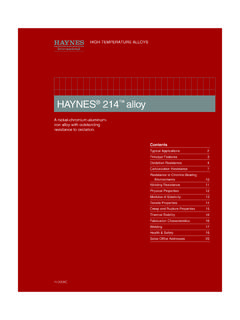Transcription of WELDING PRODUCT PROGRAMME Nickel Alloys
1 WELDING PRODUCT PROGRAMMEN ickel Alloys Customized formulations Consistent quality Single point source for complete range Technical expertise Experience in worldwide major projects Selectarc range covers a wide range of specificationsNickel AlloysProperties / Advantages Austenic Structure No phase transformations Do not harden In most environments Nickel is more corrosion resistant than Iron Alloying with chromium provides resistance to oxidation thus providing a broad spectrum of Alloys for optimum corrosion resistance in both reducing and oxidizing environments High resistance to corrosion fatigue and erosion Good stress corrosion resistance High creep strength Excellent toughness Good workability and weldabilityHighly Corrosion resistant Ni-Base Consumables for WELDING and CladdingThe main constituent of Nickel -based Alloys is Ni as major element with >50%. Nickel Alloys have a higher tolerance for alloying elements in solid solution than stainless steels and other iron-based Alloys but maintain good metallurgical stability.
2 These factors have prompted development of Nickel -based Alloys with multiple alloying additions to provide resistance to a wide variety of corrosive most important group of general-purpose Nickel Alloys are the Inconel types which are based on the general corrosion and heat resistant alloy 600 made of Ni, Cr and Fe. These Alloys are used for applications from cryogenic processes at -196 C to elevated temperatures of up to 1000 C. They are also used in power generation for steam turbine power plants, aircraft gas turbines, nuclear power plants, furnaces as well as in the chemical and petrochemical industries. WELDING Group works to ensure its customers get the full benefit of its very extensive more than six decades FSH WELDING Group has played a crucial role in the development of WELDING technology. Wherever arc WELDING processes are being used, you will find FSH WELDING Group products and know-how.
3 Selectarc Industries arc WELDING electrodes manufacturing plant has built up a reputation for leading expertise in the field, ranking it one of the global market leaders in WELDING technology. High Quality Products, its services and its highly focused Research & Development has over the years made the group a benchmark among the largest manufacturers in the world. A comprehensive range of high-quality products for WELDING and cutting, combined with a flexible range of services, forward-looking research and development and reliability becomes first choice of Customer for FSH WELDING aim is simple yet ambitious: to constantly improve to ensure the satisfaction of every single Alloys used in varied fieldsFor high temperature strength and structural stability. In high temperature dissimilar 3%, 5% and 9% Ni steels ( WELDING ). Dissimilar welds which exploit the corrosion resistance, strength and toughness.
4 For resistance to general corrosion. To give sufficient resistance against Pitting and Crevice corrosion as well as against Stress corrosion cracking in severe chloride media (see graphic). For the fabrication of: Heat exchanger piping, Evaporators, Ventilators Overlays on pumps, valves and shafts in offshore and marine environments. Conveyors belts Coal gasification Pipes and mould casting parts Gas turbines, rocket drives, nuclear reactors Forging tools Furnace parts ..In the fields of: Marine and offshore environments Power generation industries Chemical and Petrochemical industry .. WELDING Procedure1 Pre- heating treatmentPreheating Nickel Alloys prior to WELDING is not normally required. However, if the base metal is cold (12 C or less), it should be warmed to at least 20 C above the ambient temperature to prevent I the formation of condensate as moisture can cause weld porosity. Preheat of the steel component may be required when joining a Nickel alloy to carbon steel.
5 Preheat is often beneficial when joining special steel WeldingThe following hints have to be followed to get sound and highly corrosion resistant weld joints: Cleanliness is extremely important. The weld surface can be cleaned by grinding, brushing or pickling. The joint area has to be free of contaminations, especially of oil, grease, dust, ink, paint, shop dirt, etc. Oxide films have to be removed on both sides of the weld joint to a minimum of 10 mm The opening angle must be wider than for carbon steel weld preparations, in general 60-70 degrees Tack- WELDING must be performed in shorter intervals and a sufficiently wide root gap of about 2-3 mm has to be provided. When using MMA, electrodes have to be re-baked before WELDING . The stringer-bead-technique is recommended, where weaving should be restricted to times the core wire diameter (except for vertical-up- welds). The electrodes should be held in a steep angle of 10-20 degrees to the vertical and an arc as short as possible should be maintained.
6 End craters have to be filled and ground out on the root run. When WELDING the other beads, strike the arc approximately 10 mm before the end crater of the last deposited electrode, then move back to the end crater and weld over the strike of Nickel AlloysNickel Alloys can be joined, with some limitations, by all the common types of WELDING processes such as Manual Metal Arc (MMA / SMAW), Metal Inert Gas (GMAW / MIG), Tungsten Inert Gas (GTAW / TIG) and Submerged Arc WELDING (SAW). WELDING procedure of Nickel Alloys are similar to those of Stainless respect to corrosion resistance, low impurities and high impact resistance, the TIG process is thought to give best results; but due to its low deposition rate it is mainly used for root and hot passes and thin walled pipes. The application of SAW is limited to thick walled components. For some Nickel base Alloys it cannot be applied as the weld deposit is more sensitive to hot cracks than for other processes.
7 The diameter of the wire electrode is limited to 2,4mm for SAW to reduce the linear heat put. In most corrosive media, the resistance of the weld metal is similar to that of the base metal. Overmatching filler metals may be required for joints in some aggressive all processes the inter-pass temperature should not exceed 150 C and the linear energy input Es should be between 8-12 kJ/cm. Where Es = (V x A) / S x 60/1000; V= Arc voltage ( V ) ; A = WELDING current ( A ); S = WELDING speed (mm / min).In multiple pass applications, slag and oxide films have to be removed with a stainless steel brush after each : To weld Nickel Alloys in general pure argon is used but also helium or mixtures of the two can be used. For back shielding Argon or in some cases Argon plus < % Hydrogen is : Argon or Argon- Helium mixtures can be used, but for better arc stability multi-component shielding gases (Ar+He+H2+CO2) are recommended. Exemple of Creep Resistance graphicWelding Parameters - Shielding GasesStorage and HandlingIn general, MMA electrodes should be used in the dry condition.
8 In the course of time, electrode coatings will absorb moisture from the humidity of the ambient air. Therefore, it is recommended that MMA electrodes are stored in a dry location with undamaged packaging until use. Depending on the coating type and the base metal to be welded electrodes have to be re-cooked before :5 Kg plastic boxes or MetcanTIG: 5 Kg tubesMIG:D300 (15Kg), D200 (5Kg), D100 (1Kg)SAW:D400 (25Kg)Flux: 25Kg bags3 Post weld heat treatmentA post weld heat treatment (PWHT) is not recommended. Precipitation hardenable Alloys welded with hardenable WELDING products must be heat treated to develop full strength. It may also be desirable to stress relieve or anneal heavily stressed welded structures to be exposed to environments which can induce stress corrosion cracking (applies almost for all cladded components).4 Cleaning, Pickling and PassivationCleaning the surface of a Nickel alloy may be required to prevent process contamination or to ensure performance.
9 Surface conditions that can effect corrosion resistance may be due to surface contamination (including embedded iron), to mechanical damage, and to WELDING related artefacts. Some contaminants may be removed by degreasing. The use of a non-chlorinated solvent is effective (acetone). The use of a chlorinated solvent is not fabrication, metal products often come in contact with steel components and tools. Transportation, handling, forming, grinding and WELDING can all result in physical contact with iron-based structures. During such contact, iron may become embedded into the surface of an alloy component. Parts fabricated from such grades should be cleaned prior to exposure to this type of service environment to optimize resistance to PRODUCT SelectionProduct NameMain featuresDescriptionMMAWIRESB90 AWS : E NiCrFe-3 NiCrFe - type Inconel 600 Semi-synthetic basic coated electrode with 140% recovery. PRODUCT used for Oven parts, burners, Cement works , moulds, tanks, Chemical industries, petrochemical industries, Repair and AWS : E NiCrMo-3 NiCrMo - type Inconel 625 Rutile-basic coated electrode with a high recovery (170%) for WELDING of Nickel -Chromium- Molybdenum Alloys to themselves and to lower alloyed steelsHigh deposition Butt- WELDING and surfacing on low alloyed, difficult to weld steels and high strength steels.
10 Dissimilar joints. B94 AWS : E NiCrFe-2 for 5% - 9% Nickel steelsBasic coated electrode with 150% recovery. WELDING cryogenic 5 and 9% Ni-steels and high temperature steels,For CrMo-creep resistant steels to stainless steels, for repair on HK and HP reformer AWS : E NiCrMo-6 for 5% - 9% Nickel steelsBasic coated electrode with approx. 160% recovery. Construction and repair WELDING of high strength cold-tough 3; 5 and 9% Ni-steels used for transportation and storage tanks of liquid natural AWS : E NiCrMo-13 TIG NI59 / MIG NI59 AWS : ERNiMo-13 NiCrMo - type Alloy 59 Products used to WELDING Alloy 59 or C-22 type for Off-shore components, boilers, containers, piping systems in the chemical and petrochemical AWS : ~E NiCrFe-3 (For nuclear applications) TIG NI82 / MIG NI82 AWS : ERNiCr-3 NiCrFe - type Inconel 600 PRODUCT used in high temperature and Nickel Alloys in component manufacturing, furnace construction.


